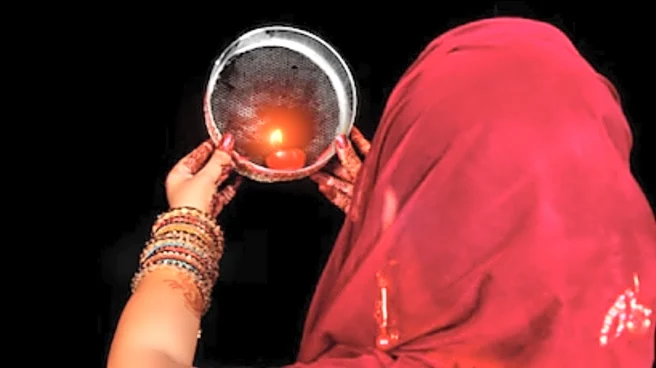Karwa Chauth is one of the most special and meaningful festivals for married women across India. On this day, women keep a fast from sunrise to moonrise, praying for the long life and good health of their husbands. They worship Maa Karva and take part in traditional rituals with devotion. One of the most beautiful parts of the evening is when women look at the moon through a sieve before breaking their fast. They then offer water to the Moon God as part of the ceremony. But have you ever wondered why women see the moon through a Chalni (sieve) on Kawva Chauth? Let’s find out.
Reasons For Using A Sieve
One of the most beautiful parts of Karwa Chauth is when women, dressed in traditional clothes, look at the moon through a (sieve) and then see their
husband’s face. The sieve creates many reflections when women look at the moon through it This tradition is also seen as a way to remove darkness and negative energy from their married life. The filtered moonlight passing through the chalni is believed to bring clarity, happiness and peace into the relationship.
According to mythology, looking directly at the moon on certain days is considered unlucky. This comes from a legend where Lord Ganesha once cursed the moon for being proud, saying that anyone who looked at it on that day might face trouble or misunderstanding. Because of this story, many women prefer to see the moon through a sieve as a way to stay connected to tradition and invite good fortune.
Prevalence of the Ritual
In some traditions, women were not supposed to look at men directly, which is why they wore veils or ghoonghats. Since Karwa Chauth involves the worship of Chandra Dev (the Moon God), many believe that a similar form of respect should be shown during the ritual. Some woman keep small diya on the sieve. However, there are small regional or modern variations in the ritual. Some women may use a dupatta or offer arghya (water) directly to the moon. Despite these differences, using a sieve is still considered the most traditional and auspicious way to perform the ritual.
Viewing Moon Through Sieve: Regional Variations
Punjab, Haryana and Uttar Pradesh – Mehendi ceremonies, folk songs and bright traditional attire make the festival joyful. Women gather in groups to sing, share stories and strengthen bonds while praying for their husbands’ well being.
Rajasthan and Gujarat – Rajasthan features the exchange of decorated clay pots symbolising unity and prosperity. In Gujarat, woman wear vibrant attire and jewellery to show their rich cultural heritage.
Madhya Pradesh – The focus is on specific prayer rituals to Lord Shiva and Parvati, along with folk songs narrating local legends to pass traditions to younger generations.
Jammu and Kashmir Region – Special prayers and worship, mud idols and traditional Kashmiri clothing create a unique celebration.
Andhra Pradesh and Telangana – Fasting festivals like Atla Tadde or Karadaiyan Nombu highlight marital devotion. Women follow strict fasts and enjoy specific foods like Atlu after prayers.
Modern Urban and Global Adaptations
In major cities, people often organise group moon viewing events and pujas following North Indian Karwa Chauth rituals, even though the festival is not traditionally celebrated in few states. Indians living abroad also observe the festival in creative ways, conducting online pujas and community gatherings.


/images/ppid_a911dc6a-image-17599176440232083.webp)
/images/ppid_59c68470-image-175991504127725868.webp)
/images/ppid_a911dc6a-image-175993163612112261.webp)
/images/ppid_a911dc6a-image-17599946903646398.webp)


/images/ppid_a911dc6a-image-176003104066572622.webp)
/images/ppid_a911dc6a-image-175999603439391875.webp)
/images/ppid_59c68470-image-175994755144679446.webp)

/images/ppid_59c68470-image-175991752714269343.webp)

/images/ppid_a911dc6a-image-175985943730258117.webp)

